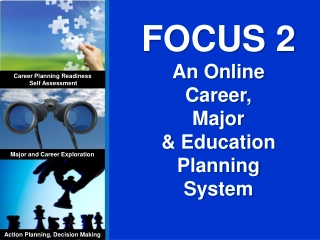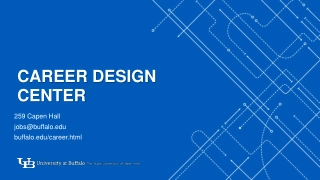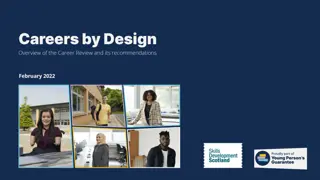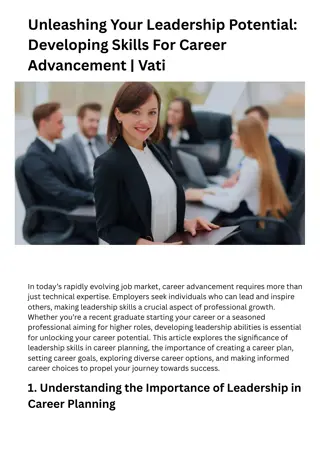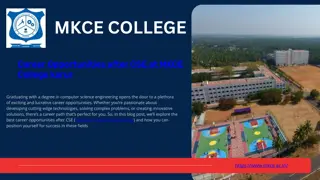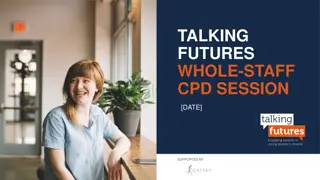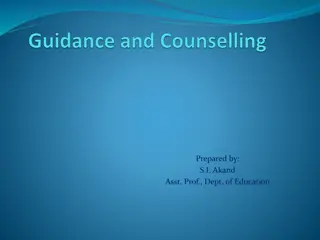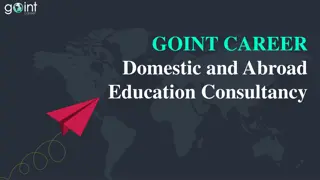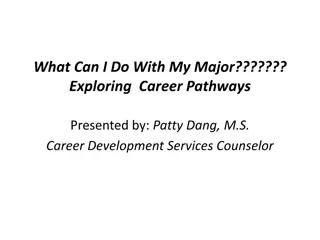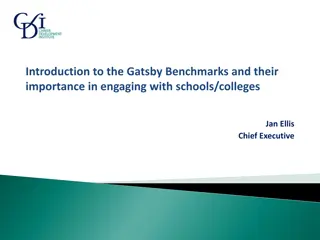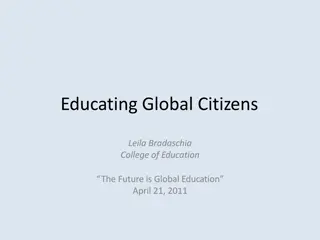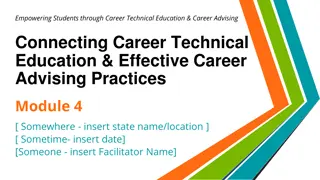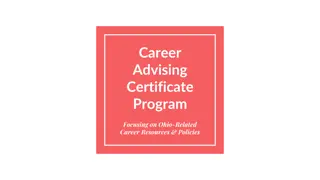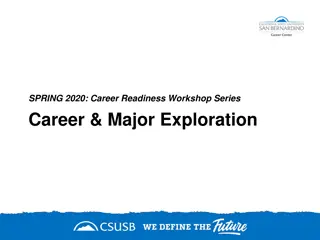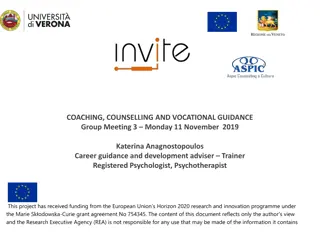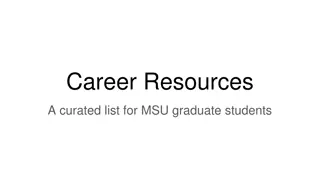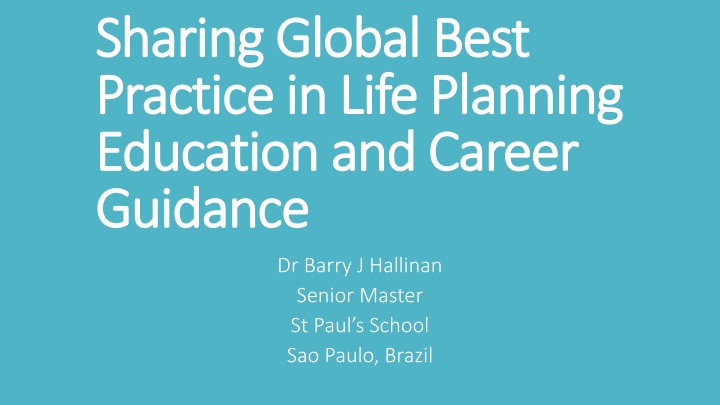
Global Best Practice in Life Planning Education and Career Guidance
Life Planning Education is a vital, ongoing process focused on personal fulfillment, career development, and holistic life planning. It involves developing a positive attitude towards learning and work, self-understanding, goal actualization, and shared commitment. The approach evolves from early childhood to post-secondary education, aiming to equip individuals with the skills and resources necessary to make informed and responsible choices throughout their lives. Dr. Barry J. Hallinan shares insights from St. Paul's School in Sao Paulo, Brazil, emphasizing the importance of connecting life planning with the school curriculum to facilitate students' growth and development as whole individuals.
Download Presentation

Please find below an Image/Link to download the presentation.
The content on the website is provided AS IS for your information and personal use only. It may not be sold, licensed, or shared on other websites without obtaining consent from the author. If you encounter any issues during the download, it is possible that the publisher has removed the file from their server.
You are allowed to download the files provided on this website for personal or commercial use, subject to the condition that they are used lawfully. All files are the property of their respective owners.
The content on the website is provided AS IS for your information and personal use only. It may not be sold, licensed, or shared on other websites without obtaining consent from the author.
E N D
Presentation Transcript
Sharing Global Best Sharing Global Best Practice in Life Planning Practice in Life Planning Education and Career Education and Career Guidance Guidance Dr Barry J Hallinan Senior Master St Paul s School Sao Paulo, Brazil
Executive summary Helping Helping all all our informed informed choices, choices, at at key that that they they can all all opportunities opportunities (current future) future). . our charges charges to to make and and responsible responsible key moments, moments, so can make make the the best (current and make so best of of and
Life Planning Education what is it? An ongoing and life-long process for personal fulfilment Develop a positive attitude towards learning and work (in general) It is not a remedial or advisory service- at specific moments It should connect with the school curriculum to allow students to grow and develop (whole person) Articulation pathways (trait and factor approach) Mindful of the above, LPE is becoming more important, challenging and indispensable.
Life Planning Education what is it? Life-long learning (life career development learning Patton/McMahon 1999) Generic skills Whole person development Self-understanding (self knowledge comes though clarification of values, interest and knowledge of personal skills) Actualisation of personal goals Shared commitment
From cradle to crib.....well almost! Caveat: Career development needs change over time... Kindergarten Grade 6: students may have an All About Me portfolio. It contains materials, information, and personal reflections compiled by the student, with the support of the teacher. Grades 7 12: students record their goals and learning in a web- based Individual Pathways Plan (IPP). The IPP becomes the main planning tool for students as they move towards the next step after school. It also gives students a valuable archive of their learning and planning resources. (Ontario system)
Life Planning Education what is it? A deliberate process to plan one s life holistically, including major life domains such as work, learning, relationships, and leisure; and to engage actively in steps for implementing these plans in one s social context . (Education Bureau, HK Government publication). Education and career/life planning helps students develop the knowledge and skills they need to make informed choices for their education, career and life outside school. Students get a chance to learn more about themselves and their opportunities, set goals and make plans to achieve them . (Ontario Education Bureau)
Diocesan Girls School Life Planning Education and Career Guidance Policy Statement Life Planning and Career Guidance at Diocesan Girls School aims to provide a holistic educational platform to support the developmental needs of all our students. It recognizes the varying needs of our students amongst different year groups as well as within individual classes, which necessitates the provision of a customized approach to Life Planning and Career Guidance. Through a coordinated approach involving the Careers, Counselling, Other Learning Activities (OLE), Scholarship and other related teams, the School aims to empower all students to make informed and responsible choices with respect to their life choices and career goals, and to nurture their social, emotional and psychological well-being. The life decisions our students make should match their own personal interests, strengths and character so that they may reach and ultimately surpass their potential. To this end, the Life Planning and Career Guidance at School encourages our students to become active and life-long learners, to uphold Christian values, to develop character, to be able to reflect and discover themselves, and to become empathetic and compassionate members of society.
Advocates for Youth Life Planning Education Chapter 1: Who Am I and What Can I Do? Chapter 1: Who Am I and What Can I Do? Chapter 2: What Are My Personal, Family, and Community Values? Chapter 2: What Are My Personal, Family, and Community Values? Chapter 3: How Well Do I Communicate with Others? Chapter 3: How Well Do I Communicate with Others? Chapter 4: Chapter 4: What Are My Relationships with Others Like? What Are My Relationships with Others Like? Chapter 5: Chapter 5: What Is Sexuality? What Is Sexuality? Chapter 6: What Does Community Mean to Me? Chapter 6: What Does Community Mean to Me? Chapter 7: Chapter 7: What Are My Goals? What Are My Goals? Chapter 8: Chapter 8: How Can I Make Good Decisions? How Can I Make Good Decisions? Chapter 9: What Are Stereotypes and Gender Roles? Chapter 9: What Are Stereotypes and Gender Roles? Chapter 10: Chapter 10: What Does it Take to Be a Good Parent? What Does it Take to Be a Good Parent? Chapter 11: Chapter 11: Can I Keep Violence out of My Life? Can I Keep Violence out of My Life? Chapter 12: Chapter 12: How Can I Take Care of My Health? How Can I Take Care of My Health? Chapter 13: What Reduces Sexual Risks? Chapter 13: What Reduces Sexual Risks? Chapter 14: How Do I Prepare for the World of Work? Chapter 14: How Do I Prepare for the World of Work?
What does it take to become......young adults Successful Successful Fulfilled Fulfilled Balanced Balanced H Happy appy
Transition points in a learners life Assumptions made Difficulty with nomenclature/topologies Home to Early Years Early Year to Primary Primary Secondary 1 Secondary 1 to Secondary 2 Secondary 2 to Tertiary Tertiary to BWW
What schools can do for their charges Being inclusive School wide Recognising best practice elsewhere Pooling resources / staff/ expertise Be flexible Differentiate operate OLE system Have a Careers Week (or day...) and out Careers on the agenda Use outside forces (PTA, local Chamber of Commerce, colleges, visiting experts)
Careers Week some ideas Plan ahead and make sure that this is an integral part of the Calendar Give teasers of what stakeholders will expect Bring all stakeholders on board (pupils, staff, parents, Board) Harness internal expertise Use external expertise (local HE/Colleges) Careers Fair/ Alum visits / Fun activities / Enrichment activities which highlight.. School-Work opportunities Act 1994 (USA) (positive job experiences) Report on all of the above so that there is a track record to build on
Quantitative and Qualitative Instruments Career Assessment takes on many guises:(Not an end but a means!) Myers-Briggs One of the most well-known assessments, the Myers-Briggs Type Indicator results in a four-letter type INFP or ESFJ, for example. The test is meant to identify basic preferences for each of four dichotomies (such as introvert and extrovert) and describes 16 distinctive personality traits. Keirsey Temperament Sorter This personality assessment is based on Keirsey Temperament Theory, which divides people into four temperaments: guardian, idealist, rational and artisan. The assessment measures how people communicate and what their actions tend to be. MyPlan.com This assessment can help you identify your motivations and what s really important to you in your career. By ranking different aspects of work, the results can encourage you to look at jobs or industries you may not have considered before. Big Five Big Five personality assessments divide people into five personality traits: openness, conscientiousness, extraversion, agreeableness and neuroticism. The assessment identifies a preference out of the five and can help you identify learning styles as well as work preferences. 16personalities This personality assessment starts with Myers-Briggs dichotomies and adds archetypes from Jungian theory as well as some from the Big Five. At the end, you ll be labeledwith one of 16 personality types with cool names like Mediator, Commander and Defender.
Quantitative and Qualitative Instruments iSeek Clusters This survey lets you rate activities you enjoy, your personal qualities and school subjects you like. Then you can see which career clusters are a match for your interests. MyNextMove This tool uses information from O*Net information, , which is sponsored by the U.S. Department of Labor, to help determine your interests as they relate to work. Unlike the other tests, this one asks you how to rate how much you d enjoy performing very specific work tasks like building kitchen cabinets, laying brick and buying and selling stocks and bonds. MAPP Test More than 8 million people around the world have taken this assessment at Assessment.com. The reason people take the MAPP is to find their way in life, he says. It tells you what you love to do and what you don t love to do. It also uses the O*Net job list to identify which jobs might be good fits. Holland Code This assessment examines your suitability with different careers based on six occupational themes: Realistic, Investigative, Artistic, Social, Enterprising and Conventional. The test identifies your top interest area and how it compares to the other areas, and what this means for your career interests. PI Behavioral Assessment The Predictive Index predicts primary personality characteristics that describe, explain and predict day-to-day workplace behaviors, says Greg Barnett, a Boston-based industrial and organizational psychologist who is responsible for setting and executing the scientific agenda for the Predictive Index. This rigorously tested study looks at your strongest workplace behaviors and determines your management and influence styles.
ACT ACT College and Career Readiness College and Career Readiness Standards, Benchmarks, and The Holistic Framework Planning for Future Success Starts Now A Holistic Framework for College and Career Readiness Shifts in education and the workplace are changing how we must think about college and career readiness in America. It s that simple. To help people navigate these shifts from kindergarten to career (K Career), ACT has created a holistic framework for understanding education and work readiness, navigating life s transition points, and achieving success .
To provide a more holistic and integrated picture of education and work readiness from kindergarten to career, ACT has created a framework of readiness that includes knowledge and skills organized into four broad domains Core academic skills in mathematics, science, and English language arts (ELA) based on an expanded, more granular definition of the skills and mapped to learning progressions from kindergarten through career (K Career) Cross-cutting capabilities, such as critical thinking, collaborative problem solving, and information and technology skills Behavioral skills related to success in education and the workforce, such as dependability, working effectively with others, adapting, and managing stress Education and career navigation skills related to education and career paths, including self knowledge of abilities, values, likes, and dislikes; knowledge about majors and occupations; and a variety of skills related to education and career exploration, planning, and decision making
Final Thoughts All Schools are capable of placing a serious focus on life planning Buy-in from major stakeholders would be considerable if presented in the right way Think big, start small, consider local, think global, start early adopt a whole school/whole person approach (Individual Pathways Plans) school/whole person approach (Individual Pathways Plans) adopt a whole If a team does not exist, identify champions at school who are passionate about what they do and feel so they can contribute to the life long planning project Carry out an audit to help guide first steps or take you to the next level In an ideal world, a staff member would be employed to head up a Life Planning Unit Create space, opportunities, identify (abilities, interests, strengths, potentials).

